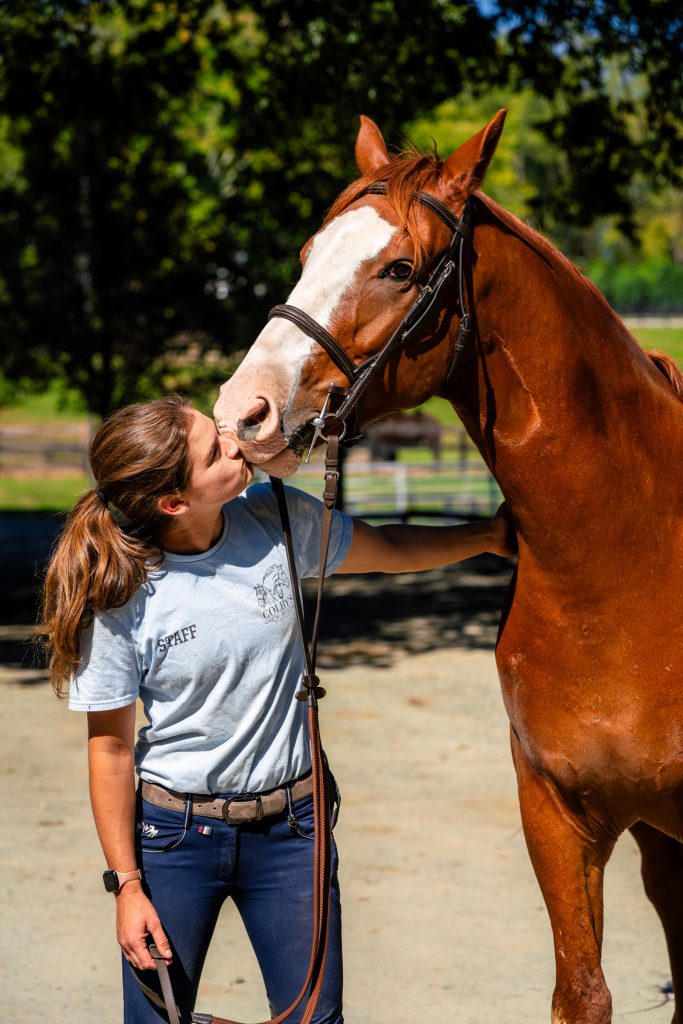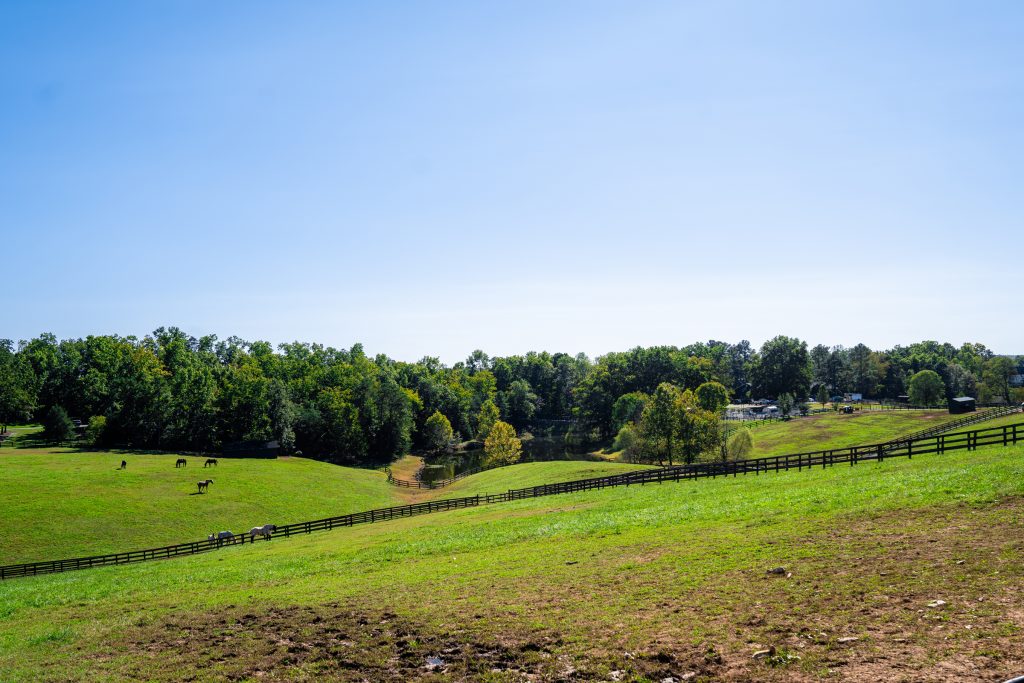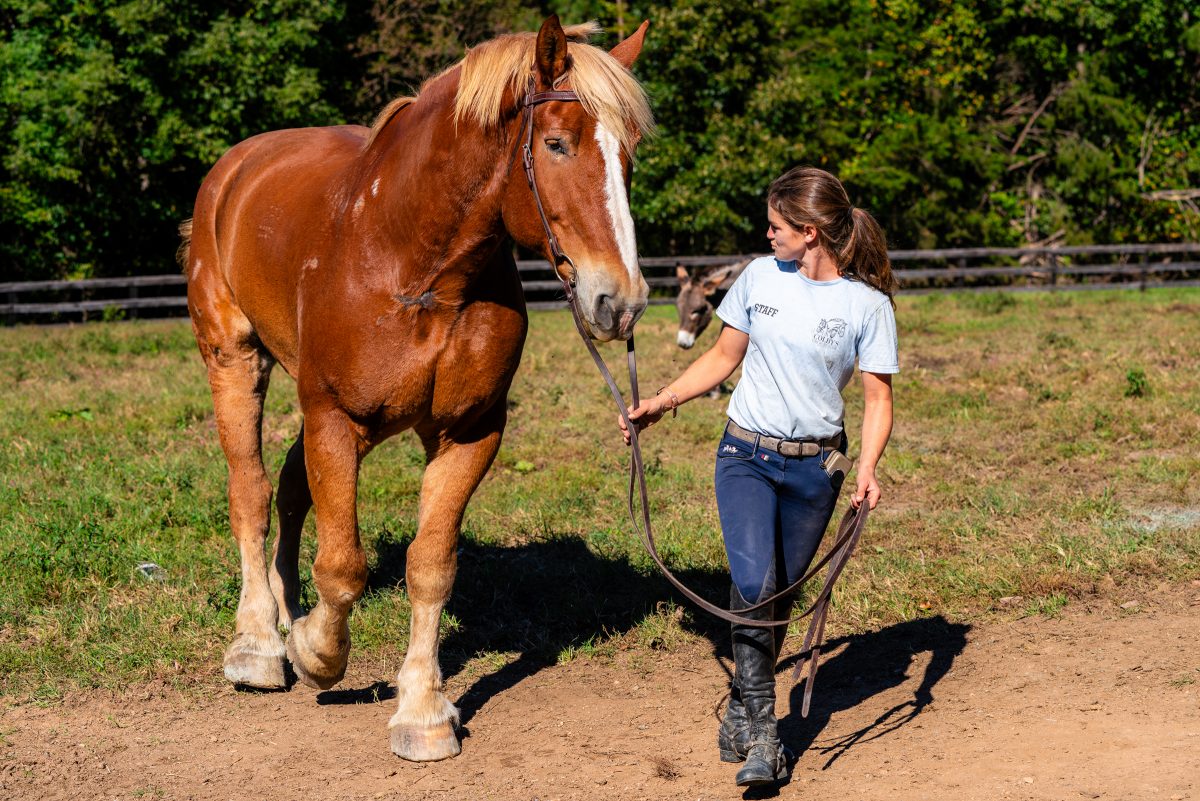Colby’s Crew started with one horse and one decision from the heart.
Colby, a 4-year-old chestnut stallion with white markings, had run out of options. Allison (Ally) Smith, an experienced equestrian studying nursing and training horses on the side, saw an online post about him: “Bound for slaughter. Needs experienced handler.”
“He was flashy and beautiful, and they were only asking $875,” Ally recalls. She bought him, sight unseen.
Ally’s wife Olivia, who is active on social media, posted a video on Facebook of Colby in the kill pen (where animals are held before being shipped to slaughter). “This was July 2020, the middle of the pandemic, when TikTok was just taking off,” she says, “and the video blew up.”
Thirty days later, the shipper arrived at Ally’s family’s Warrenton farm with Colby. The horse was spirited, she had been told; in reality, he was almost feral. The truck driver was afraid to go into the van, so Ally walked in with a lead rope and brought Colby out. “The shipper’s mouth dropped open,” Olivia recalls. “Ally was yelling at her father, ‘Close the gate! Close the gate!’ because she knew if Colby got loose in the field we’d never catch him.”
That’s when Ally turned to Olivia and said, “I’m going to ride him.”
Ally went out to the paddock 10 times a day, working to build Colby’s trust. He was in poor condition and had clearly been mistreated, kicking and biting at any touch. But Ally’s patience and calm won out, as she and Colby developed a deep bond. Within a month he was letting her ride him. Olivia filmed and posted the whole process, and created an internet phenom. By early 2021, Ally and Olivia decided to take on another rescue; then came two more. And then they met Big John.
“We went to an auction in West Virginia one weekend in April 2021,” Ally recalls. “We were just going to look, strolling around, and I went by this stall and said, ‘Oh my God!’ I hadn’t been around draft horses before—this guy didn’t even fit in the stall.” She ran to get her wife, and when they came back a girl was riding Big John around.

“I looked up, and up, and up,” Olivia says. (Big John is a Belgian, the second-largest draft breed, and he’s 20 hands—which is 6’8″ at the shoulder.) “He was so lame, and he was exhausted. His feet were in terrible shape, he had scars, he had sores, but he was trying to do whatever was asked of him.”
This time it was Olivia who said, “I’m going to buy that horse.”
She started posting Big John videos and pleas for donations, and her online followers responded: “We had $5,000 pledged in 15 minutes.” Fortunately, their trailer was large enough for Big John (“I was scared at first, but he was so gentle,” says Ally), and a neighbor had a field available for his quarantine. When he was released into the field, the giant Belgian who had been worked almost to death took a long roll and then a good look around. “Then he kind of collapsed,” recalls Olivia. “He had been drugged to get him through the auction.”
That was when the pair decided they wanted to save horses that had reached the bottom.
“We hadn’t started out thinking of this as a career,” Olivia says. “But the internet was pushing us along, saying, ‘You need to start a 501(c)(3).’” Colby’s Crew Rescue was founded in 2021, and in 2022 the couple moved to Keswick to build the organization, while Ally continues her graduate nursing studies at UVA. This year CCR saved more than 600 animals, buying them before slaughter or through owner surrenders.
The two women began going to kill pens as well. They never knew what they would find there. They once discovered 13 Belgians waiting to be shipped. (Draft horses bring a good price when you’re selling meat by the pound.)
Olivia had had it. “I said, ‘We’re buying all of them.’ I went online and stayed online until we had raised enough to pay for the first four to six months of care for every one of those horses.”

That has become CCR’s methodology. Getting a rescue horse from purchase through quarantine, vet evaluation and routine treatment, rehabilitation, and training costs on average $4,500; CCR’s online ask is calculated to cover both the animal’s purchase price and its maintenance cost through adoption. Clearly, that figure can increase substantially if the animal has serious injuries or illness, is pregnant, or needs extensive training, so CCR also charges an adoption fee. Still, some animals are just not suitable for adoption, and at any one time, CCR has about 50 animals in sanctuary farms, whether for hospice or retirement. And then there are the 10 or so equines that will stay at CCR as “organization ambassadors”—like Colby and Big John.
Equine rescue, while heartwarming, takes an enormous amount of labor and expert help. CCR works closely with vets at Virginia Tech’s Marion duPont Scott Equine Medical Center in Leesburg, Virginia, and the University of Pennsylvania’s New Bolton Center. (One of the largest kill pens is in New Holland, Pennsylvania, close to Lancaster and Amish country, where a large percentage of the rescue animals come.)
CCR arranges for a vet to be on site to triage animals as soon as they are purchased. Unless they need emergency care, the animals are sent to one of five quarantine farms CCR contracts with for 60 to 90 days of quarantine and further evaluation. If humane euthanasia is necessary, it’s done by a licensed vet.
Every animal gets a vet check weekly (more often if needed); a farrier visit every six weeks for hoof care; and a full wellness check including grooming and lots of love every day. Once it’s fit, the animal is brought to the Keswick facility to be evaluated by Ally and Olivia, who assign the horses to one of CCR’s network of trainers for at least 30 days of training to get them ready for adoption.
Every CCR adopter gets vetted, including home photos and veterinarian references. The adoption contract is strict. Every animal has been microchipped, and will be tracked by CCR; monthly photo updates are required; the adopter has to keep CCR informed of any sale or transfer; and there’s a $10,000 penalty for breaking the contract. For its part, CCR will take back any animal for any reason, and if that animal requires surgery or humane euthanasia, CCR will help cover the cost.

Ally’s equine expertise and ability to bond with weary, sick, and traumatized animals is at the heart of Colby’s Crew, while Olivia’s impressive social media skills and ability to capture the pathos and triumphs of its work have made CCR famous. The Crew has almost 4 million followers on Facebook, TikTok, and Instagram who donate, share, and devotedly follow the rescued horses. “We raise all our money online, through donations—we don’t do solicitations, we don’t have corporate sponsors,” says Olivia. “Ninety-five percent of the money we take in goes back into buying and caring for our rescues.”
CCR gets some online criticism claiming it is supporting kill pens by buying from them, but the couple doesn’t see it that way. They see their job as saving sentient beings that deserve better than a truck ride to a cruel death. Eliminating the slaughter pipeline will likely take public pressure and political action; last year, the U.S. House of Representatives considered a bill to ban equine slaughter or export for human consumption, and this year animal advocates in Canada are pushing for a ban on the export of live horses for food.
Animal-lovers, of course, know that CCR’s equines are actually rescued. Online scammers post kill-pen photos with pleas for donations to “save this animal” when the horse has already been sold, or killed, or never existed.
Happily, in the last few years CCR has built an enormous community that is invested in Colby, Big John, and all their equine friends. Sure, these fans respond to calls for money—but they also clamor for updates on Sterling, a young mare facing severe medical issues; on Dudley, the newborn donkey who needed emergency care for deformed legs; and Onyx, the big black draft mule whose brother Obsidian was rescued as well. Visitors and adopters who come to the Keswick farm ask to say hello to Big John and his understudy, Big Sam, who is only 18 hands (6′ tall). And they are excited to see each and every animal that will be rescued next.
… It takes a village
Perhaps this area’s best-known equine rescue is Hope’s Legacy, also named for a special horse. “Hope was an off-the-track thoroughbred,” says Maya Proulx, Hope’s Legacy executive director. “She’d been off the track only six months, and I was her fifth owner. She was one of the sweetest mares I ever met.” The organization’s name honors Hope and all the horses that might easily have been written off.
A Nelson County native and lifelong horse person, Proulx founded Hope’s Legacy as a 501(c)(3) nonprofit in 2008. All its rescue animals have been donated. About half are “owner surrenders,” animals at risk of being auctioned off when their owners die, or face serious illness or financial setbacks, while the rest have been seized by law enforcement in cases of neglect or abuse.
“Most animal control offices don’t have facilities for large animals,” Proulx says, “so if there are horses involved, they have to scramble. I wanted to serve as a resource for them.” Hope’s Legacy has taken in neglected animals from the 2015 Peaceable Farm raid in Orange County; a 2016 Nottoway County seizure that included pregnant mares; and a 2023 Shenandoah County case involving 98 neglected thoroughbreds.
The organization also runs twice-yearly training sessions that are open to animal control officers from all over the state. “Virginia has no requirement for equine training for these people, and many don’t know anything about handling horses,” says Proulx.
At the moment, Hope’s Legacy has 74 horses in rescue—35 living on its 172-acre primary farm in Afton, and the rest in foster homes. Proulx credits the organization’s network of vets, fosterers, and trainers, as well as “120 incredibly dedicated volunteers” who do everything from feeding (two shifts every day) and barn care, to working with the horses on being haltered, led, and handled. One of the feeding shift volunteers has fundraising experience, and now works full-time raising money for Hope’s Legacy and its equines.
Hope’s Legacy runs a variety of activities to build community awareness and generate donations, as well as educational programs for kids (including the popular Books at the Barn). “Part of our mission is to end neglect and abuse,” says Proulx, “and that starts with education.”
